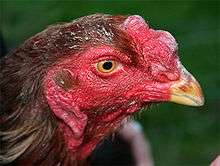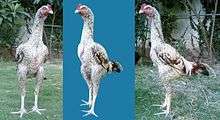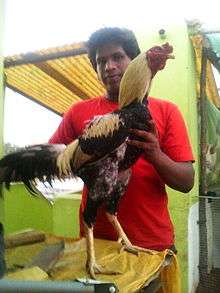Asil chicken


The Asil or Aseel is a breed of chicken originating from South Punjab / Sindh area of Pakistan . Fowl are found throughout Southeast Asia, such as Shamo and Thai Game. The breed is generally unstandardised in South Asia and India, but popularity has increased in the western world in recent times with the breed standardised in the British,[1] Australian[2] and American standards.[3]
Description and history
Asils were first used for cock fighting and may be considered fighting cocks. Aseel is noted for its pugnacity. The chicks often fight when they are just a few weeks old and mature roosters will fight to the death. Hens can also be very aggressive towards each other.
Towards humans Asil are generally very tame and trusting. There are anecdotes where they have come to their keepers for other things than food, for example to get the keeper to open the door to the coop so they can get to roost.[4]
The hens are not good layers, but are excellent sitters. Laying depends on the Asil variety, the small Asil are known to be very poor layers, sometimes laying just 6 eggs a year, whereas larger Asil can lay around 40 eggs a year.
In the U.S., the breed is on the "Watchlist" (2012), by the Livestock Conservancy.[5] The Aseel breed is found in almost all states of India, but abundant in Andhra Pradesh.
Varieties

There are many varieties of Asil, some are standardized for shows such as the Reza Asil in the UK, some are simply named after the area where they are bred such as the Mianwali Asil from Pakistan or the colour, red/wheaten Asil are generally known as "Sonatol".
There are also hen-feathered Asil knows as "Madaroo" these are found in various colours, but the cocks come with feathers in hen colour, don't have sickle feathers in the tails and miss the large hanging feathers on the saddle. This variety is very rare.
Asil with feather beards under their beaks known as "muffed" and with tufts on the top of their heads known as "tasseled" are also seen, but are very rare especially outside India/Pakistan.
Bhaingam Asil variety have a large single comb but confirm to all the other Asil standards.
Broadly speaking, Asil in Europe are categorized and shown under these three types:
Long Tail Parrot Beak Aseel
Long Tail Parrot Beak Aseels is a hybrid variety of Aseel Breed Chicken which is only available in the southern part of India especially in Tamil Nadu.These Aseels Come with A gigantic appearance of huge size and Long Tail Along with a beak which is very short and Thick similar to the Parrot therefore it is called the Long Tail Parrot Beak Aseels.
Birds are categoried based on the style and colours, some of the Colors are
1. Mayil Karuppu (Black and yellow)
2. Kagam/sengaruppu (Black and red)
3. Sevalai (Red)
4. Karum Keeri/Senkeeri (black/red dotted)
5. Sambal Boothi (Grey)
6. Kokku Vellai (White)
7. Noolan (white and black)
8. Pondram (Golden brown)
The average size of a Good Long Tail Parrot Beak Aseel weigh up to 5 to 7 kg from 1 years of age.These Aseels have been exported to China And Thailand in our early days but now export of Birds has been banned from India especially these kind of birds.However People from all over the world come and purchase Eggs of these long tail aseels .The average Life span of these Aseels are from 5 to 7 years
The Average price of a good long tail Parrot beak aseel as of 2016 is from 15000Rs to 100000Rs depending on the Quality of the tail size and beak position.The Average price of 2 month chicks pair as of 2016 is 10000 Rs .
The number of breeders have rose for these breeds due to the high demand in these breeds.
It is been carried out as a matter of pride in villages of south Tamil Nadu more than hundreds of years. Madurai, Alanganallur, Dindigul, Trichy, Palani, Udumalai, Pollachi, Salem, Namakkal are the major sectors where we can spot this breeds. There are legends who framed their own breed lines in this variety of birds which will replicate certain characters and appearance generation by generation, Aaladi Alanganallur, Meesaikarar Ramasamy Ottachathiram, kumari Chandra, Periyakottai Murugan, Jawlikarar Dindigul, Prakash Integrated Farm (Kovilur) Dindigul, Ponnuchamy Palani, Suseendran Salem, Sengattu Vellayyan are the notable breeders here.
There are also Three main registered clubs for these aseel breeders who breed these aseels
1. All India Aseel Organisation - AIAO
2. Dindigul Aseel Breeders Association
3. Indian Aseel Breeders Association Palani
Every member of these clubs are well known breeders of their home town.Every year these clubs conduct Aseel Exhibition where people from All over India Come to display their Aseels with passion and pride as they are rearing this very rare variety of aseels
Reza Asil
Height: Up to 50 cm tall. Weight: Maximum weight for the hens is 1.8 kg, max weight for the cocks is 2.7 to 3 kg.
This type is standardized by the Asian Hardfeather Society in the UK and is seen at shows throughout the UK, but is quite rare.
This group of Asil reached worldwide popularity due to books and articles written by gamefowl experts such as Herbert Atkinson, Siran and Paul Deraniyagala from Sri Lanka and Carlos Finsterbusch from Chile. The Reza Asil family according to the old (Western) gamefowl literature is subdivided into following strains: (Amir) Ghan (Dark-Red), Sonatol(Light-Red), (Siyah) Rampur(Black), Kalkatiya (Kaptan)(Speckled-Reds) and Jawa(Duckwing). All these strains are identified by their specific color, these colors do not necessarily correspond with the area where the birds come from.
In colonial times other colors such as whites, spangles, golden etc. were regarded as inferior. At present day the "classic" strains and names given mentioned by Atkinson are more or less forgotten. The native people in India, Pakistan, Bangladesh and Sri Lanka only know the Reza-type Asil by their local names.
Kulang Asil
Height: Up to 75 cm tall. Weight: 5 to 7 kg.
The large Asil are divided into sub-varieties : North Indian, South Indian and Madras type. The North and South Indian varieties don't differ much. Only type of comb, shape of the beak and body shape are different. For example: Northern type = slender, Southern type = heavier build. The Madras Asil however is significantly different. They have a lower station, are heavier build and stronger boned. These birds often come in a bluish colour. This variety is found in the deep south of India, the Tamil Nadu state.
Sindhi Aseel

Sindhi Aseel or Sindhi Asil (Sindhi: سنڌي اسيل, Urdu: سندهي اسيل) is a breed of chicken and as from the name, originates from Sindh (one of 4 major provinces of Pakistan). These cocks, or fighting cocks, are noted being tall, heavy and good at fighting, so they are bred mainly for cockpit. These Aseels are characterised by a muscular but compact body, broad shoulders, wings carried against the body, short and hard feathers, drooping tails, a large curved beak similar to that of an eagle, pea comb and no wattles.
Mianwali
This breed is mainly found in Mianwali district of Pakistan. However, since its arrival, this breed has risen to popularity in Pakistan, currently the primary game breed used in the pits also preferred by gamblers. It is smaller compared to Sindhi aseels weighing between 1.5 and 3.5 kg depending on the preference of breeders. It is much faster and a better head hitter usually comes in small to medium height. A good Mianwali aseel should kill its opponent within a few minutes. They have been known to kill bigger roosters because of their speed and accuracy. They come in various colors such as Java(duckwing), Lakha (reddish), black and various others depending on the combination used in breeding. Very hard and a brave fighter with attitude to inspire, excellent in naked heels and metal spurs. There are many sub breeds of this breed owing to the combination used in breeding. A good tested Mianwali rooster would usually have offspring of a similar quality. Typical description would be small curved beak, strong joints, pearl/white/yellow eye color, short crow, small comb and do not have heavy body structure. May look smaller than other breeds but is excellent spurer.
Java Aseel
Java aseel is one of the most used and best fighter cock in Pakistan/India. It is mainly found in Punjab region, its origin was from Mianwali district, Jawa Aseel is recognized by his black and yellow colour.

It is also found in red and black colours and orangish most of the times. It is usually mixed with desi cock breeds for superior fighting skills. Its weak point is its long legs and eta more hits in fighting. It is also found in South India in Kolar district of Karnataka belts. Height of Java Asil is 50 cm and weight of Java is 7 to 8 kg.
Amroha
Origin This is a rare and very contested breed of Aseel used in Pakistan and India.While originating in the Amroha state of india the evidence of this breed in India remains precarious today. Very few of these roosters exist in their pure form even in Pakistan where various groups of aseel breeders tend to associate it with Peer Shah Alam Shah of Mianwali. Physiological Charachteristics They are known to be small to medium like Mianwali. Glossy and hard feathered Amroha aseels are known for their geometrically round physical traits. The shape of their face is round with a strong beak itself round to some extent. The jaw bone on their face is slightly uplifted and eyes are human like slightlyBold text closed and narrow wirth prominent eyebrows. Another usual charachteristic is their thick round neck slightly uplifted in cobra snake position especially when they are held in hand. Their color is usually black breasted red or black breasted dark brown (color of dates). Another characteristic perhaps due to heavy inbreeding consists in the small size of their legs and feet . Usually they have a very small length of their feet about 3 cm maximum with small feet . As to their weight people make different claims usually in their pure form they are small but heavy with thick bone structure (Like Pit-bull dog ) reaching 2 Kg weight depending upon the feed. Their tails and wings have white feathers. Amroha aseels are very beautiful to look at. They are more talkative and produce more noise than other aseels. HATCHING Amroha hens would hatch 9 to 12 eggs which they lay in the month of March to April and usually in September as well. A successful hatch will keep the Amroha hen busy for at least six months sometimes even up till the male chicks start crowing.They will often hatch identical to their parents.
Bantam Asil
Weight: Up to 0.75 kg.
Bantam Asil have been created at the end of the 19th century by an English breeder named William Flamank Entwisle. The breed got very popular after its creation but after a couple of decades interest in this variety slowly died out. Until the beginning of the 1980s nothing was heard about these little Asil. A Belgian breeder named Willy Coppens created them again using Shamo (chicken), Indian Game and Reza Asil. The breed was also introduced again in the Netherlands and United Kingdom. At present day Bantam Asil are quite popular and they are bred in various colors.
Lasani Aseel Breed
Pakistani Aseel breeders have developed different varieties of aseel breeds. But one of the rarest breed is what they call Lassani Aseel breed. They are medium size birds with powerful strikes to earn them the title of neck breakers. This breed has a typical parrot like beak and small neck size. Unlike mianwali they have a particular fight style. They don't like jumping over the opponent rather they like to come closer to the opponent touching him with their front body and than attacking on the neck. So in a typical mianwali versus Lassani fight you will see mianwali birds dominating initially but as soon as they are tired of jumping around and land on the ground somewhat tired lasani breed cock will finish the game with a couple of hits in the neck. Amroha and lassani are closely related however lassani breeds have smaller necks and often closed eyes only few families of Nawab have got this breed in its pure form. And the notion that they are bengam type aseels is mistaken.[6]
References
- ↑ British Poultry Standards. Blackwell Publishing. 2008. p. 47.
- ↑ Australian Poultry Standards. Victorian Poultry Fanciers Association Ltd trading as Poultry Stud Breeders and Exhibitors Victoria. 2012. p. 188.
- ↑ "APA Recognized Breeds and Varieties" (PDF). American Poultry Association. Retrieved 18 January 2013.
- ↑ The game fowl colours, Owen Dickey, privately published
- ↑ "The Livestock Conservancy". The Livestock Conservancy. Retrieved 2014-04-29.
- ↑ "Asils Home - Andhraasil". Andhraasil.webs.com. Archived from the original on 2014-05-31. Retrieved 2014-04-29.
- Oriental Gamefowl, Horst W. Schmudde, Authorhouse, ISBN 1-4208-7681-3
- The complete encyclopedia of chickens, Esther Verhoef & Aad Rijs, Rebo International, ISBN 90-366-1592-5
- "The Aseel (or Asil)". The Society for the Preservation of Poultry Antiquities.
- "Aseel". mypetchicken.com.
- "International World of Asil". Archived from the original on 2010-01-11.
External links
| Wikimedia Commons has media related to Asil. |